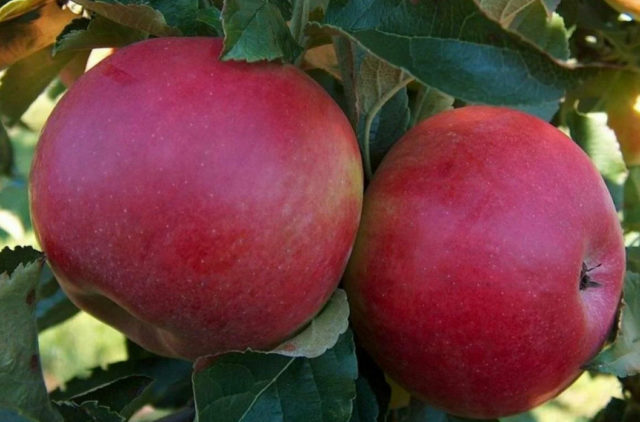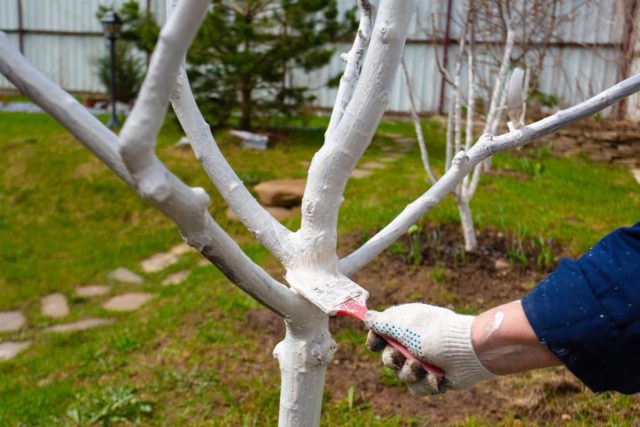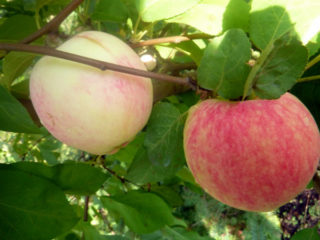Content
Growing apple trees in Siberia can be a risky undertaking; in cold winters, they are more likely to freeze out. Only cold-resistant varieties can grow in this region. Breeders are working in this direction as well. One of the new varieties is the Bayan apple variety intended for cultivation in Western Siberia.
Breeding history
The variety was bred from two varieties - "Altai purple", which was taken as a winter-hardy maternal form and a hybrid obtained from the crossing of "Gornoaltaisky" and "Bellefleur Chinese". The new apple tree turned out to be large-fruited and winter-hardy. The variety is marked as promising for industrial cultivation.
Description of Bayan apple-tree variety with photo
Variety "Bayana" was included in the State Register in 2007, zoned for the West Siberian region. Refers to the late autumn group.
Fruit and tree appearance
The tree grows quickly, its height is average (it can reach 4-4.5 m). Crohn of moderate density, narrow pyramidal. Leaves are medium in size, green, elongated, shortly pointed. The apples are large, one-dimensional, weighing on average 165 g, round in shape, with slight ribbing. The skin of the fruit is greenish-yellow, with a large purple blush and rare small green subcutaneous dots.

Large-fruited is one of the main characteristics of the apple tree of this variety.
Life span
With good care, the Bayana apple tree can live for more than 50 years. Fruiting often up to 40 or more seasons. If a tree is not properly cared for, its lifespan is reduced.
Taste
The pulp of the "Bayana cream" apple-tree is fine-grained, medium-dense, very juicy and tender. Its taste is sweet and sour, the assessment of tasters is 4.6 points. Fruit odor is moderate.
Growing regions
The Bayana apple tree can be grown in the Urals, Altai, Kemerovo, Tomsk, Novosibirsk, Tyumen and Omsk regions. Even in more northern regions, such as Khanty-Mansi Autonomous Okrug and Yamalo-Nenets Autonomous Okrug.
Yield
In the first years of fruiting (fruits begin to ripen in the fourth season), Bayan apple trees show an average yield of 4.1 kg per square meter. m. In subsequent years, the yield increases to 11-14 kg from 1 sq. m. m.
Frost resistance of Bayan's apple tree
High cold resistance, wood can withstand frosts down to -46 ° C. The drought tolerance of this apple tree is average.
Disease and pest resistance
Excellent scab resistance, not affected by powdery mildew. Sometimes it can be sick with cytosporosis and lichen.

If the storage rules are observed, apples can lie 4 months after being harvested.
Flowering period and ripening period
Apple-tree "Bayana" begins to bloom in 1-2 ten days of May, in Altai earlier - at the end of April. Flowering lasts approximately 1.5 weeks, depending on the weather. The fruits ripen in the third decade of September. The technical ripeness of apples can be determined by the purple hue that appears on the skin.
Pollinators
The Bayana variety is bee-pollinated, self-fertile. To increase the volume and quality of fruits, other varieties of apple plants can be planted nearby, for example, "Gornoaltayskoye", "Grushovka", "Melba", "Siberian souvenir", "Bolotovskoye", "Vishnevoe", etc.
Transportation and keeping quality
The fruits of the Bayan apple tree have a dense skin, therefore they tolerate transportation well and are not damaged by mechanical stress. They are distinguished by good keeping quality, can withstand storage for 4 months.
Advantages and disadvantages
The advantages of the Bayana variety are not limited to cold resistance, the apple tree shows good productivity, early maturity, and there is no periodicity of fruiting. Fruit ripening may drop slightly during rainy seasons with strong temperature fluctuations in spring and summer. The variety is resistant to common fungal diseases, the fruits are well stored, and can tolerate transportation.
Disadvantages: low yield in the first seasons of fruiting, shedding of the ovary during ripening.
Landing rules
The place is selected well lit, open, but not blown by the wind. It is not advisable to place apple trees next to other tall trees or buildings so that they do not end up in their shade.
Apple trees grow best in fertile loamy and sandy loam soil with neutral acidity. In most cases, the soil needs preparation before planting a tree: the introduction of organic fertilizers in the form of humus (1.5 buckets per planting pit) and ash (2 kg each).
Planting in spring allows the tree to take root over the summer, which increases its chances of survival. In autumn, you can also plant, but at least 1.5 months before the onset of a period of persistent cold weather.
Young 1- or 2-year-old seedlings take root best, older trees are worse. For a standard tree, planting holes are dug at least 0.7 m in diameter and 0.5 m in depth. The distance between seedlings is 4 by 4-4.5 m.
Planting sequence:
- Lay a drainage layer of small stones, chips and broken brick at the bottom of the pit.
- Place the seedling in the middle, spread the roots so that they are directed in all directions.
- Fill the hole with soil, water and slightly compact.
- Cover the near-stem surface with plant material or agrofibre.
You can put a peg next to a tree and tie a trunk to it. Thanks to this, it will grow evenly, and not obliquely.
Growing and care
After planting, the Bayana apple-tree seedling only needs watering. Moisten the soil often for 1.5 months, making sure that the soil does not become dry. Then the frequency of irrigation is reduced, watered only in the absence of natural precipitation. After each watering or rain, the soil in the near-trunk circles is loosened. So that this does not need to be done, the soil is covered with mulch.

In early spring, it is recommended to whitewash the trees to protect them from burns and overwintering pests.
Apple trees are fed for the 2nd year, there is no need for fertilizers in the first season. In the spring, organic matter is introduced under the trees - humus and ash in an amount, as when planting. Fruiting apple trees are fertilized at least 3 times per season: in the spring before bud break, after flowering and in the middle of the fruit growth period. At this time, you can use both organic and mineral fertilizers.
Pruning begins the following spring after planting. The tops of the central conductor and side branches are removed from the tree. In a formed apple tree in spring or autumn, broken, frozen or dried branches, shoots growing inside the crown are cut out.
For the prevention of fungal diseases and the spread of pests, starting in spring, they are sprayed with fungicidal preparations and insecticides. Usually 1-2 treatments carried out during the season are enough to avoid the development of diseases and the reproduction of harmful insects.
For the winter, the soil under the trees is covered with a layer of peat, foliage, hay, sawdust and other suitable covering material. In early spring, the trunk and lower parts of the branches are whitewashed with lime to protect against burns and pests.
Collection and storage
The fruits ripen by the end of September. They are filmed in full or technical ripeness. The method of consumption is universal, that is, they can be eaten fresh or processed into juice and canned foods.
The Bayan apples are kept in a cool and dry place; a cellar is well suited for this purpose. Under optimal conditions, the fruits can lie until February.
Conclusion
The Bayan apple variety is intended for cultivation in all regions of Western Siberia and the Urals. Its main advantage is frost resistance. In addition, the variety is characterized by early maturity, yield, good taste and keeping quality of fruits.








